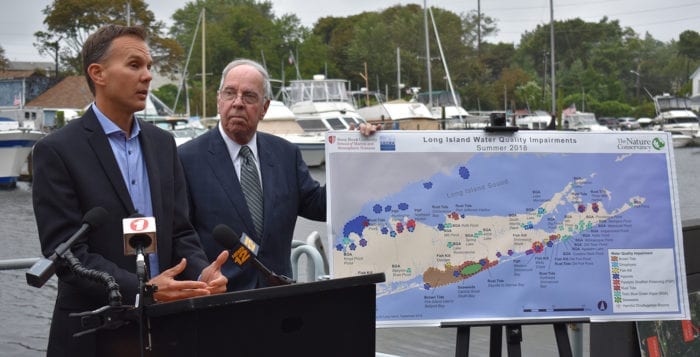Data suggests worrisome trends for LI’s water

Long Island’s water is facing a dangerous threat — not a mythical sea monster, but harmful and poisonous algal blooms. Recently released data showed the problem was more far reaching this summer than years past.
The Long Island Clean Water Partnership, an advocacy collective supported by the Rauch Foundation, that includes members from Stony Brook University and the Long Island Pine Barrens Society headed by Dick Amper, released an annual water status report Sept. 25 that showed new harmful algal blooms in Port Jefferson, Northport and Huntington harbors and in North Shore ponds and lakes.
“Every single water body across Long Island, be it the North Shore or the South Shore, East End, Suffolk County, Nassau County, all had significant water impairments during this time frame,” said Christopher Gobler, endowed chair of Coastal Ecology and Conservation at the Stony Brook University School of Marine and Atmospheric Sciences. “We would call this a crisis.”
“We are the nitrogen pollution capital of America.”
— Kevin McDonald
The Island-wide study, which was conducted from May through September, showed Northport Harbor suffered a bloom of Dinophysis, a type of algae that releases a powerful neurotoxin that can affect shellfish. Both Northport and Huntington harbors showed a rash of paralytic shellfish poisoning in other marine life from eating shellfish.
In May, shellfish fishing was temporarily banned in Huntington and Northport harbors by the New York State Department of Environmental Conservation because of PSP. The harmful poison began to wane in June, Gobler said, and those bans have since been lifted, according to an automatic message put out by the state DEC.
Stony Brook University’s Roth Pond has been experiencing for years summer blooms of poisonous blue-green algae, a type that is harmful to animals. This past summer the researchers saw the algae spread into neighboring Mill Pond in Stony Brook. In 2017, Suffolk County had more lakes with blue-green algal blooms than any other of the 64 counties in New York, according to the report.
The summer also saw the rise of a rust tide in Port Jeff Harbor and Conscience Bay caused by another poisonous algae, which, while not dangerous to humans, is dangerous to marine life. Gobler said while it did not necessarily lead to fish kills along the North Shore, places like Southampton saw the deaths of tens of thousands of oysters and fish due to rust tide. If the problem persists, Port Jeff might start to see a fish die-off, which could have lasting implications to the local ecology.
The algal blooms and hypoxia were both exacerbated by a particularly warm summer, a trend expected to continue due to climate change. In coming years, Gobler said he expects the number of dangerous algae to spread because of this trend.
“We’re expecting that temperatures will rise 5 or 10 degrees this century, so we need to make changes or things will get significantly worse,” Gobler said.
The prognosis looks grim, with multiple other places across Long Island experiencing harmful algal blooms, but the source is already well known. This year’s study cites heavy loads of nitrogen pollution from sewage and fertilizers as the ultimate source of the algal events, particularly the nitrogen waste from old cesspool systems leaking into local waters.
Suffolk County and several state and local politicians have been advocating for changes, either for creating sewer systems — such as Smithtown’s projects in Kings Park, Smithtown Main Street and St. James — or by creating financing programs for property owners to overhaul waste systems.
In 2014 Suffolk County Executive Steve Bellone (D) called nitrogen pollution the county’s “environmental public enemy No. 1.” Since then the county has worked with local scientists and engineers to craft technology that could replace Long Island’s old cesspool and septic tanks, but some of those replacement systems have been very cost prohibitive. Suffolk has made some grant money available to those interested in upgrading.
New York Gov. Andrew Cuomo (D) signed legislation in April that put $2.5 billion toward clean water protection and improving water infrastructure, including $40 million for the new sewer systems in Smithtown and Kings Park, and adding a rebate program for those upgrading outdated septic systems. Suffolk County and scientists from Stony Brook University are currently working on cheaper nitrogen filtration systems, but commercial availability of those systems could be years away.
“Technology and governmental policies are rapidly changing to address our island’s water crisis, but we need to increase our pace of change.”
— Adrienne Esposito
Kevin McDonald, the conservation project director at The Nature Conservancy, said that there is a strong impetus for all of Long Island to change its waste standards.
“We are the nitrogen pollution capital of America,” McDonald said. “We can’t reverse climate change by ourselves, but with the right support and engagement and leadership we can aggressively respond to this problem at a faster pace than at present.”
Many of these areas now experiencing algal blooms were only encountering hypoxia, or a depletion of dissolved oxygen in water necessary for sea life to survive, in the same report released back in summer 2017. Last year Mount Sinai Harbor was spared from severe hypoxia, but now has seen a decrease in necessary oxygen levels this past summer. Gobler said it wouldn’t be out of the question that Mount Sinai Harbor could experience a potentially dangerous algal bloom next summer.
One thing is for sure, according to Gobler: Long Island will experience more hypoxia and harmful algal blooms until new waste systems can catch up to the amount of nitrogen that’s already in the water.
“Technology and governmental policies are rapidly changing to address our island’s water crisis, but we need to increase our pace of change,” said Adrienne Esposito, the executive director of the environmental advocacy group Citizens Campaign for the Environment.






